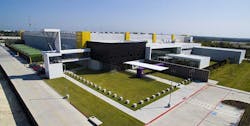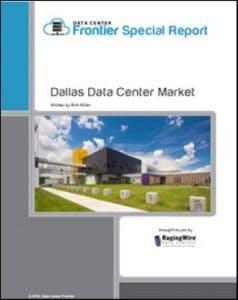Broad Demand Drives Data Center Boom in Dallas-Fort Worth
We continue our series of stories on the leading geographic markets for data center space. Data Center Frontier is partnering with DatacenterHawk to provide in-depth market reports on each city we profile. This time, we revisit the Dallas data center market, which is notable for its diverse data center ecosystem. This is the first post in a four-part series, and provides a Dallas data center market overview and analysis.
Download the full report.
The Dallas Fort Worth region data center market is one of the largest and most active data center markets in the United States. It is currently experiencing a data center building boom, with hundreds of megawatts of potential capacity in the pipeline. The Dallas market is benefiting from excellent power and fiber infrastructure, competitive economic incentives and robust competition among service providers.
Dallas is notable for the diversity of its data center ecosystem, with strong demand for retail colocation, wholesale data center space, powered shell and build-to-suit projects. The market is boosted by its location in the center of the country, and sees demand for space from multiple business verticals, including hosting and cloud players as well as enterprise customers in finance and energy. Dallas also benefits from the fact that the state of Texas operates its own power grid, isolating it from power outages from other regional interconnection markets.
The Dallas area is home to 2.99 million square feet (SF) of commissioned data center space, representing 334 megawatts (MW) of commissioned power, according to market research from datacenterHawk. That makes Dallas the third-largest market for data center capacity in the U.S., trailing only Northern Virginia and Silicon Valley, and just ahead of Chicago. In square footage, Dallas is the second-largest market, slightly ahead of Silicon Valley. Demand for space is fairly strong, as reflected in the vacancy rate of 15.0 percent in the region.
Dallas is currently the focus of a data center building boom, with most of the industry’s major wholesale data center providers adding capacity and creating multi-building campuses for future growth. There was 50 MW of available power capacity at the close of 1Q of 2018, with an additional 11 MW under construction. In addition, there is a whopping 570 MW of additional capacity in the planning stages, indicating a strong expectation of growth.
Will Dallas Win Hyperscale Deals?
Will Dallas begin winning hyperscale projects? This is a matter of debate among industry veterans with experience in the Dallas market, with some anticipating that larger hyperscale requirements are coming, while others believe that these expectations are premature. The answer to the “hyperscale question” will be a key factor in the data center absorption rate in Dallas, and the pace of growth going forward.
The region’s data center capacity is spread across several sub-markets, including major carrier hotels in downtown Dallas, a nexus of wholesale data centers in the “Telecom Corridor” in Richardson and northern suburbs. The current hot spot for new development is Garland, where city-owned power and the availability of land is creating a growing cluster of wholesale data center providers. To the West, there is a growing cluster in Fort Worth featuring a Facebook data center campus and a huge new project led by T5 Data Centers.
Here’s what the data centers will look like at T5@Alliance, the new project from T5 Data Center and IPI. (Image: T5 Data Centers)
Over the past two years, the Dallas market has emerged as a focus of significant investment by leading players in the data center industry. This includes new ownership and strategic focus impacting major carrier hotels in downtown Dallas, the entry of new players in Dallas suburbs, and significant expansions by existing providers.
Over the last three years, Dallas/Fort Worth has drawn large corporate relocations. Most companies go to Texas due to the state’s central location, affordable real estate prices, and good tax incentives. The Dallas area in particular has a diversified labor force, with strong growth recently from the technology and services industries.
In the first quarter of 2018, the DFW market saw job growth of 3.7%, slightly ahead of the pace of job growth across the rest of the state (3.5%) and the United States overall (2.3%), according to data from the Federal Reserve Bank of Dallas. In addition, the Dallas market’s unemployment rate is currently 3.6% and has been steadily declining since 2009.
Background & History
The early growth of DFW’s data center market was focused in downtown Dallas. Because the central business district is rich in telecommunication infrastructure, several large office buildings were retrofit for data center use, most prominently the Infomart Dallas, 2323 Bryan Street and the former Federal Reserve Building. These buildings typically attract smaller colocation customers, along with telecommunications companies.
As the colocation market grew significantly in 2009 and 2010, these companies expanded beyond downtown. An obvious expansion route was the northern suburbs of Dallas, which boomed during the 1990s when the “Telecom Corridor” attracted dozens of leading companies in the telecom, software and semiconductor sectors. This area was hit hard during the dot-bust of 2001 to 2003, but has seen a new round of growth as Dallas has emerged as a hotbed for hosting and colocation.
Cities like Richardson, Plano, Carrollton, Allen and Garland benefited from the growth by offering sites and buildings with expansion opportunities. In addition, most colocation providers in the DFW market are choosing to construct new facilities instead of retrofitting existing buildings worthy of conversion.
Over the next few weeks, the Data Center Frontier series on the Dallas Data Center Market will cover the following topics for the region:
- Trends in Supply
- Trends in Demand
- Business Environment
Download the full Data Center Frontier “Dallas Data Center Market” special report, courtesy of RagingWire Data Centers.
And for further coverage, check out Data Center Frontier’s page dedicated to the Dallas Data Center Market, that will provide the latest stats and info on this quickly growing area that is continuing to experience a data center boom.
About the Author



